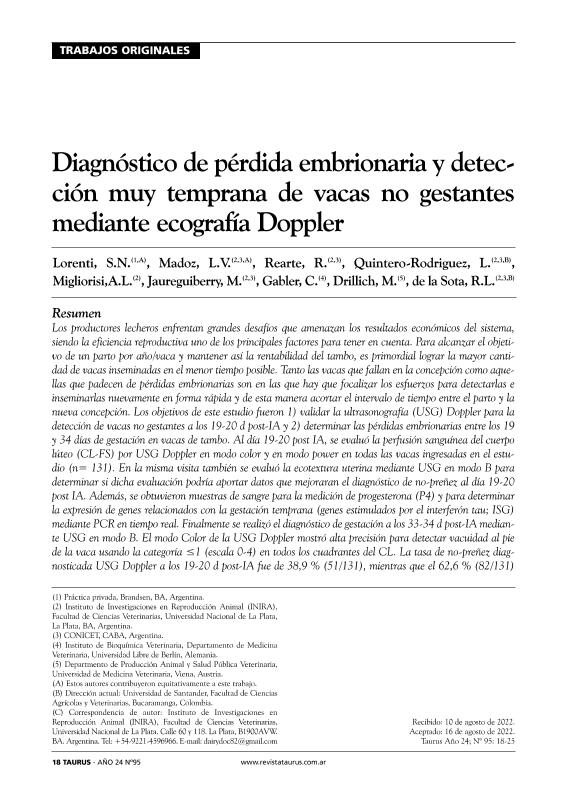Artículo
Los productores lecheros enfrentan grandes desafíos que amenazan los resultados económicos del sistema, siendo la eficiencia reproductiva uno de los principales factores para tener en cuenta. Para alcanzar el objetivo de un parto por año/vaca y mantener así la rentabilidad del tambo, es primordial lograr la mayor cantidad de vacas inseminadas en el menor tiempo posible. Tanto las vacas que fallan en la concepción como aquellas que padecen de pérdidas embrionarias son en las que hay que focalizar los esfuerzos para detectarlas e inseminarlas nuevamente en forma rápida y de esta manera acortar el intervalo de tiempo entre el parto y la nueva concepción. Los objetivos de este estudio fueron 1) validar la ultrasonografía (USG) Doppler para la detección de vacas no gestantes a los 19-20 d post-IA y 2) determinar las pérdidas embrionarias entre los 19 y 34 días de gestación en vacas de tambo. Al día 19-20 post IA, se evaluó la perfusión sanguínea del cuerpo lúteo (CL-FS) por USG Doppler en modo color y en modo power en todas las vacas ingresadas en el estudio (n= 131). En la misma visita también se evaluó la ecotextura uterina mediante USG en modo B para determinar si dicha evaluación podría aportar datos que mejoraran el diagnóstico de no-preñez al día 19-20 post IA. Además, se obtuvieron muestras de sangre para la medición de progesterona (P4) y para determinar la expresión de genes relacionados con la gestación temprana (genes estimulados por el interferón tau; ISG) mediante PCR en tiempo real. Finalmente se realizó el diagnóstico de gestación a los 33-34 d post-IA mediante USG en modo B. El modo Color de la USG Doppler mostró alta precisión para detectar vacuidad al pie de la vaca usando la categoría ≤1 (escala 0-4) en todos los cuadrantes del CL. La tasa de no-preñez diagnosticada USG Doppler a los 19-20 d post-IA fue de 38,9 % (51/131), mientras que el 62,6 % (82/131) Dairy producers face important challenges threatening the system's financial results, making reproductive efficiency one of the most important. To achieve the goal of a calving per cow/year and thus maintain the profitability of the dairy, it is essential to achieve a high number of inseminated cows in the shortest possible time. Cows that fail to conceive and those that suffer embryo loss are the ones that we should focus on detecting and inseminating them promptly, shortening the time interval between calving and new conception. The objectives of this study were 1) to assess the ultrasound (USG) Doppler for the detection of non-pregnant cows at 19- 20 d post-IA and 2) to determine the embryo loss between 19-34 d of pregnancy in dairy cows. In all cows included in the study (n=131), the corpus luteum (CL-FS) perfusion was assessed by the color and the power mode of the Doppler USG. In addition, the uterine echotexture was evaluated by USG mode B to predict if, including this information, the precision of the USG Doppler at 19-20 d post AI improved. At the same time, blood samples were collected to measure progesterone (P4) and to determine the expression of genes related to early pregnancy (interferon-stimulated genes; ISG) by real-time PCR. Finally, the pregnancy diagnosis was performed at 33-36 d after IA using USG mode B. Color mode showed higher precision in detecting non-pregnant cows using category ≤1 (scale 0-4) in all CL quadrants. The non-pregnancy rate at 19-20 d post-AI was 38,9% (51/131) by CL-FS Doppler USG. In contrast, the non-pregnancy rate at 33-34d post-AI was 62,6 (82/131) by B-mode USG based on the lack of embryo visualization. The presence of a thick endometrial layer and the visualization of the uterine stratum vascular at 19-20 d post-AI was related to the non-pregnancy diagnosis at 33-34 d post-AI (p<0.001). Based on the expression of ISG in cows with positive CL to Doppler assessment and with P4 >1ng/ml at 19-20 d post-AI, we detected that 28,1% of the cows potentially lost the pregnancy between 19-34 d. Doppler USG allowed the detection of non-pregnant cows between 19-20 d post-AI, and the additional B-mode ultrasound evaluation of the uterine echo structure improved the detection of non-pregnant cows. The early diagnosis using these techniques is a valuable and quick tool to be implemented in resynchronization protocols to minimize open days.
Diagnóstico de pérdida embrionaria y detección muy temprana de vacas no gestantes mediante ecografía Doppler
Título:
Diagnosis of embryonic loss and very early detection of non-pregnant cows by Doppler ultrasound Summary
Lorenti, N. S.; Madoz, Laura Vanina ; Rearte, Ramiro
; Rearte, Ramiro ; Quintero Rodriguez, Luis Ernesto
; Quintero Rodriguez, Luis Ernesto ; Migliorisi, Ana Lorena; Jaureguiberry, María
; Migliorisi, Ana Lorena; Jaureguiberry, María ; Gabler, C.; Drillich, M.; de la Sota, Rodolfo Luzbel
; Gabler, C.; Drillich, M.; de la Sota, Rodolfo Luzbel
 ; Rearte, Ramiro
; Rearte, Ramiro ; Quintero Rodriguez, Luis Ernesto
; Quintero Rodriguez, Luis Ernesto ; Migliorisi, Ana Lorena; Jaureguiberry, María
; Migliorisi, Ana Lorena; Jaureguiberry, María ; Gabler, C.; Drillich, M.; de la Sota, Rodolfo Luzbel
; Gabler, C.; Drillich, M.; de la Sota, Rodolfo Luzbel
Fecha de publicación:
08/2022
Editorial:
Ediciones Taurus
Revista:
Taurus
ISSN:
1515-3037
Idioma:
Español
Tipo de recurso:
Artículo publicado
Clasificación temática:
Resumen
Archivos asociados
Licencia
Identificadores
Colecciones
Articulos(CCT - LA PLATA)
Articulos de CTRO.CIENTIFICO TECNOL.CONICET - LA PLATA
Articulos de CTRO.CIENTIFICO TECNOL.CONICET - LA PLATA
Citación
Lorenti, N. S.; Madoz, Laura Vanina; Rearte, Ramiro; Quintero Rodriguez, Luis Ernesto; Migliorisi, Ana Lorena; et al.; Diagnóstico de pérdida embrionaria y detección muy temprana de vacas no gestantes mediante ecografía Doppler; Ediciones Taurus; Taurus; 95; 8-2022; 18-25
Compartir



